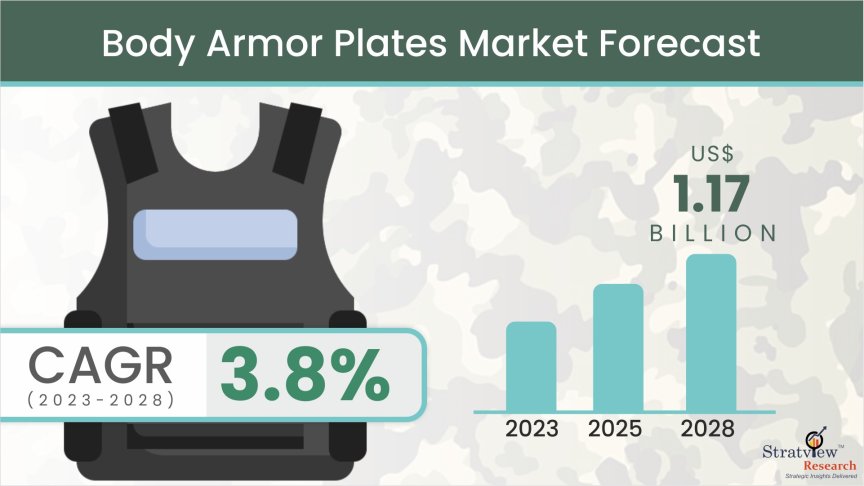Body armor plates are essential protective gear designed to safeguard military personnel, law enforcement officers, and civilians from ballistic threats. As the security landscape evolves, the demand for advanced body armor solutions continues to grow. This article provides an overview of the applications, technology, and industry insights into body armor plates.
According to Stratview Research, the body armor plates market was estimated at USD 0.93 billion in 2022 and is likely to grow at a CAGR of 3.8% during 2023-2028 to reach USD 1.17 billion in 2028.
Applications of Body Armor Plates
Military Applications
Military forces worldwide use body armor plates to protect personnel in combat situations. These plates are designed to withstand high-velocity projectiles and provide vital protection to soldiers against ballistic threats. Military-grade body armor plates are often made from advanced materials such as ceramic, polyethylene, and steel, offering various levels of protection based on the threat environment.
Law Enforcement and Security
Law enforcement officers and security personnel rely on body armor plates for personal protection during tactical operations and high-risk situations. These plates are integrated into tactical vests and plate carriers, providing essential protection against firearms and other ballistic threats encountered in the line of duty. Lightweight and flexible options are preferred to ensure mobility and comfort during extended wear.
Civilian Protection
Body armor plates are increasingly adopted by civilians concerned with personal safety and security. Private security personnel, emergency response teams, and individuals in high-risk professions utilize body armor plates for protection against potential threats. Civilian applications include personal defense, security operations, and protection in hazardous environments.
Types of Body Armor Plates
Ceramic Plates
Ceramic body armor plates offer exceptional ballistic protection while being lightweight and comfortable to wear. Materials such as alumina and silicon carbide are commonly used due to their high hardness and ability to dissipate the kinetic energy of projectiles effectively. Ceramic plates are favored for military and law enforcement applications where mobility and protection are critical.
Polyethylene Plates
Polyethylene body armor plates are lightweight and flexible, providing excellent multi-hit capability and comfort for prolonged wear. These plates are constructed from ultra-high-molecular-weight polyethylene (UHMWPE) fibers, which absorb impact energy and distribute it throughout the material. Polyethylene plates are popular in civilian and law enforcement sectors due to their flexibility and cost-effectiveness.
Steel Plates
Steel body armor plates are known for their durability and affordability. These plates are typically made from high-strength steel alloys, offering robust protection against ballistic threats. Steel plates are heavier than ceramic and polyethylene alternatives but provide reliable protection in high-threat environments. They are commonly used in military and security applications.
Industry Insights
Technological Advancements
The body armor plates industry is witnessing continuous technological advancements aimed at enhancing protection and comfort. Innovations include the integration of nanotechnology for improved material properties, lightweight designs for increased mobility, and modular systems for customizable protection solutions.
Global Market Growth
The global demand for body armor plates is expanding, driven by increasing security concerns, military modernization programs, and rising investments in law enforcement and civilian protection. Regions such as North America, Europe, and Asia-Pacific are witnessing significant market growth, with manufacturers expanding production capacities to meet the growing demand.
Regulatory Standards and Compliance
Manufacturers adhere to stringent regulatory standards to ensure the performance and safety of body armor plates. Standards such as NIJ (National Institute of Justice) in the United States and similar certifications in other regions specify ballistic resistance levels and performance requirements for body armor plates used by military and law enforcement agencies.
Sustainability and Environmental Impact
There is a growing focus on sustainability in the body armor plates industry, with manufacturers developing eco-friendly materials and production processes. Efforts are underway to reduce the environmental footprint of manufacturing while maintaining the high-performance standards required for ballistic protection.
Conclusion
In conclusion, body armor plates play a critical role in safeguarding military personnel, law enforcement officers, and civilians from ballistic threats. Advances in materials, technology, and manufacturing processes are driving innovation in the industry, resulting in lighter, more durable, and effective body armor solutions. As the global security landscape evolves, the demand for reliable and high-performance body armor plates is expected to increase, positioning the industry for continued growth and development. Manufacturers and stakeholders are poised to capitalize on these opportunities by delivering cutting-edge protection solutions tailored to the diverse needs of end-users worldwide.






Comments